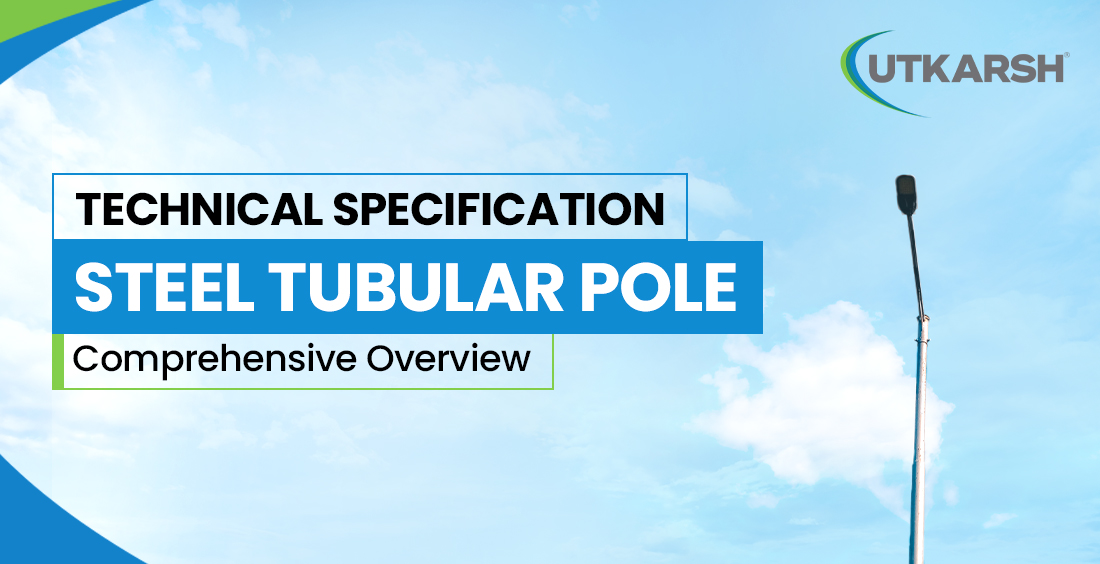Technical Specification Steel Tubular Pole Comprehensive Overview

Not only do steel tubular poles serve the purpose of a utility pole or street light, but they also support infrastructures. In every case such as transmission of power, lighting, or telecom purpose, technical specification of steel tubular pole is important for engineers, manufacturers, and planners. This blog simplifies all the processes in one place, ranging from the materials used to manufacturing, the design type, and load capacity.
Here’s something else worth checking: 5 key insights about Steel Tubular Poles by Utkarsh India
1. Material Composition and Quality Standards
The most essential part of any steel tubular pole specification is its material. These poles are fundamentally made with high-grade steel sourced from mild steel IS:2713 or any other internationally acknowledged standard. Its skeletal structure contains carbon, manganese, and several other alloys that add strength and improve weldability.
These poles go through a quality control cycle which includes flattening tests, bend tests, and chemical analysis. For outer installation, galvanization is a must. It adds value when it comes to resisting corrosion. The use of hot-dip galvanizing supplements zinc, tampering the protective coat, making the pole last longer, easier to upkeep, and greatly increasing its longevity.
2. Types of Poles and Their Structural Design
Performance is influenced by design. Steel tubular poles come in two categories: swaged and seamless, both with precise manufacturing processes. The tapering of the swaged poles from bottom to top allows for maximal structural strength while reducing material weight. They are best suited for medium to heavy-duty applications.
Steel tubular poles specification includes varying lengths—between 3 meters and 16 meters—and differing load bearing capacities. Standard cross-sections comprise circular, octagonal, and conical shapes, each offering specific advantages depending on the intended use.
Designs also take into account wind pressure, seismic zones, and load applications, allowing for use in both rural and urban infrastructure projects.
3. Performance Metrics and Load Bearing Capacity
Knowledge of the load bearing capacity is important to determine which technical specification steel tubular pole fits a specific project. Capable of withstanding horizontal loads such as wind and vertical loads from mounted fixtures or transformers, the capacity depends on a few factors including the height, diameter, wall thickness, and installation depth of the pole.
All designs undergo deflection tests under load and stress points to ensure they meet national and international safety standards. Performance, especially for critical installations, is further enhanced with proper grounding and base plate anchoring.
4. Applications Across Industries
Street lighting to transmission of electric power, every street tubular pole specification varies by industry. This is how they serve each sector differently:
- Street Lighting: These poles prop various fixtures and give the height needed for better lighting.
- Electric Power Transmission: The poles' high load bearing capabilities make them the best fit for 11kV to 33kV distribution lines.
- Telecommunication: Their heavyweight but strong poles allow easy mounting of antennas and other equipment.
- Railways and Highways: Used in signals, signs, and lighting systems because of their strength and durability.
All of these applications require compliance with a certain set of technical standards, placing the understanding of technical specification steel tubular pole important.
5. Installation and Maintenance Insights
Installation practices play a major role in the long-term performance of steel tubular poles. Proper excavation, base plate grouting, and anchoring ensure structural integrity. Poles must be installed with the correct orientation, taking into account load direction and environmental exposure.
Maintenance is minimal due to galvanization, but regular inspections for rust, physical damage, or foundation issues are recommended. In high-risk areas like coastal or industrial zones, additional protective coatings may be used as part of the steel tubular pole specification.
As one of the leading steel tubular pole manufacturers in India, we specialize in producing high-quality poles using advanced manufacturing techniques. Our swaged poles are crafted in world-class ERW plants—Eastern India’s first ISI-certified facilities—signifying our commitment to excellence.
Read more: What are the applications of tubular poles in urban infrastructure?
Conclusion
Getting the steel tubular pole specification right means ensuring safety, efficiency, and long-term reliability. Whether you're working on infrastructure, urban planning, or commercial installations, detailed knowledge of design, material quality, load performance, and manufacturing standards can make all the difference. Choose manufacturers who adhere strictly to these standards to ensure your project’s success.
FAQs:
What is a tubular pole used for?
A tubular pole is used to support street lights, traffic signals, signage, and electrical wiring in outdoor and industrial settings.
Is steel tubular pole rust proof?
Steel tubular poles are not completely rust-proof, but they can be made resistant to rust through galvanization or protective coatings.
What is the code for steel tubular poles?
The code for steel tubular poles in India is IS 2713.
How much does an 8 meter tubular pole weigh?
An 8-meter tubular pole typically weighs between 40 to 80 kg, depending on its diameter and wall thickness.